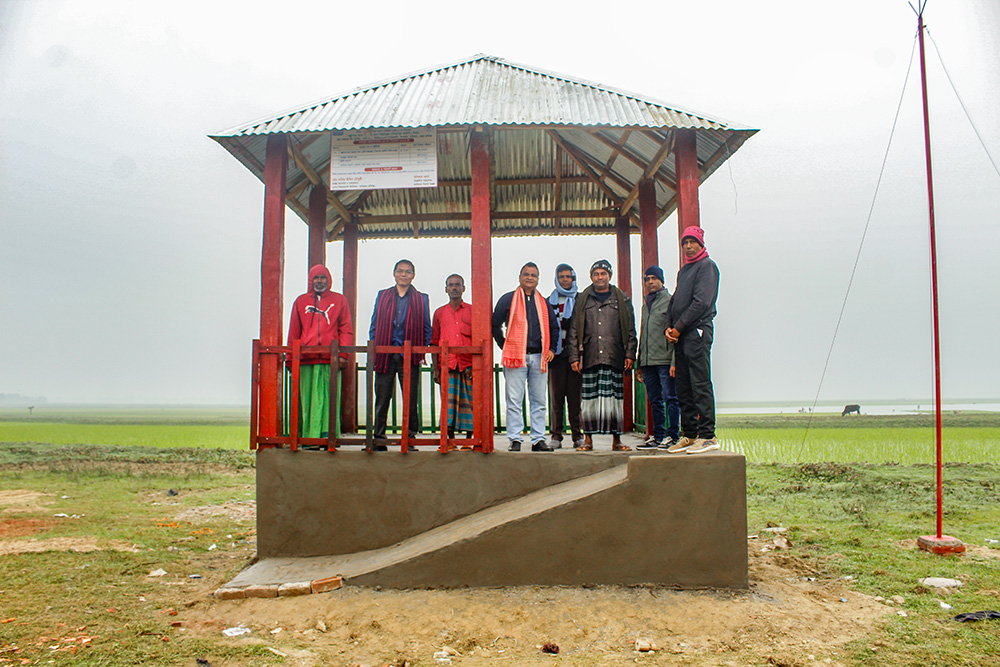Caritas Bangladesh provides shelters to prevent deaths from lightning strikes

Ziaul Haque, 50, a farmer from Langadu sub-district in Rangamati, southeastern Bangladesh, was the sole breadwinner of his family. On June 15, he was struck and killed by lightning while returning from the local market in a boat on Kaptai Lake with food for his family. Three other people died in the same area due to lightning strikes.
On June 19, two people lost their lives in two separate lightning strikes during a storm in Bagerhat, southwest Bangladesh. The incidents occurred in the villages of PC Dema and Hedayetpur in Sadar sub-district.
One of the deceased, Saidur Rahman, 27, had taken cows from his house in the morning to graze them in the nearby Panchamala field, according to family members. Heavy rain began in the afternoon and Rahman tried to return home with them. He was struck by lightning and died instantly. Ujol Rahman, who was with him, was seriously injured. Three of the cows and a buffalo were also killed.
Abdul Mannan, 80, a resident of Bolipur in Savar, near Dhaka, died from lightning strikes on August 20, 2022. He was working in a field at the time.
His son, Sorafat Ullah, told EarthBeat: “The sky was covered by a black cloud. When it started raining, my father could not return home as he was elderly. He died due to lightning strikes.”
The 55-year-old farmer said they were unaware of the dangers of thunderstorms. “Nobody told us about the dangers of lightning strikes. If my father had known, he might not have stayed outside during the rain,” said Ullah, who is now more aware of such risks.
One of the deadliest lightning strikes in Bangladesh occurred on August 4, 2021, on the Padma River in Shibganj sub-district of Chapainawabganj in northwestern Bangladesh. In the morning, a boat left Chapainawabganj with a groom on board and headed for Dakshin Paka village in Shibganj. At around 12:30 pm, as the boat was approaching Shibganj, it was struck by lightning, damaging the boat and killing 16 people. Several others were injured and admitted to the sub-district health complex.
According to the United Nations, an average of 300 people die from lightning strikes in Bangladesh each year. This number is significantly higher than in countries such as the United States, where fewer than 20 people die from lightning strikes each year on average.
Experts say deaths from thunderstorms are increasing in Bangladesh due to changing weather conditions, increased lightning strikes and the felling of large trees that could absorb the force of lightning. They believe these deaths can be prevented through education and initiatives.
In August 2015, the government declared lightning strikes a disaster due to the increasing number of deaths caused by them. Several projects were launched to prevent deaths from lightning strikes, one of which was palm tree planting. The disaster management agency was supposed to plant 4 million palm trees under this project, but failed to achieve this target.
A freelance consultant on disaster risk management and climate adaptation, who is also a lecturer at the Institute of Disaster Management and Vulnerability Studies, Dhaka University, suggested that a simple solution would be to plant tall trees across the country. “We are not protecting the old trees. Even if trees are destroyed, nothing is done about it. So where will the protection come from?” asked the consultant, who wished to remain anonymous.
Gauhar Naeem Wara, a renowned author and researcher, stressed that it is crucial to stop the felling of palm trees. “Cutting of fresh palm trees should be stopped in our country. The district commissioner of Narail could save 1,600 palm trees a year if he wanted to. People are making boats out of palm trees and this should be stopped by the authorities,” he said.
He also mentioned that field workers in Nepal and India who worked with farmers who had survived lightning strikes found that farm workers who wore rubber shoes were significantly more likely to survive than those who were barefoot. “If that’s the case, why not worry about providing shoes instead of installing expensive shields like lightning rods?” he said.
The Catholic Church in Bangladesh responded to the recent increase in lightning deaths with an approach other than sheltering and planting trees or providing protective shoes. Caritas Bangladesh, the social wing of the Catholic Church, has constructed a lightning shelter at Panchauniya Haor (wetland) in Baniachang sub-district of Habiganj district as part of the family and community level flood preparedness project.
Abu Taher, junior program manager for disaster management in Caritas Bangladesh’s Caritas Sylhet Region, told EarthBeat that many farmers and fishermen go to the Panchauniya wetland in Baniachang. During rainstorms, “people use our lightning shelter. Previously, people stayed outdoors because of the risk of lightning strikes,” he explained.
“In Baniachang sub-district, 59 people have died from lightning strikes in the last five years,” Taher said. Caritas Bangladesh inaugurated the shelter in December 2023, and so far 380 farmers and fishermen have found shelter there during rainstorms.
Maloy Kumar Das, Project Manager of Baniachang Sub-District, approved the lightning protection project of Caritas Bangladesh and praised the initiative.
Catholic Boniface Khonglah, Regional Director of Caritas Sylhet Region, said the launch of the lightning shelter is an important and commendable initiative of Caritas Bangladesh. “This project underlines Caritas’ commitment to resilience and community protection and is a significant step towards sustainable development and humanitarian excellence. Habiganj is a lightning hotspot. Every year, many people die due to lightning strikes. To save them, we have launched this small project,” he told EarthBeat.
Residents of Baniachang sub-district thanked Caritas Bangladesh for setting up the shelter. “We used to be afraid to stay in the wetland during rains. Now we have moved to the shelter which is safe and secure. We are grateful to Caritas,” Mamun ur Rashid, a fisherman living in Kumri village in Baniachang, told EarthBeat. The 45-year-old also said that one of his relatives, who was the sole breadwinner of his family, died in the wetland last year.
In addition, some Catholic priests in Bangladesh are raising awareness about thunderstorms. Father Dominic Halder, a priest of Bagerhat Catholic Church in Khulna Diocese, told EarthBeat: “Our people are not very educated and do not know much about thunderstorms. So I advise them not to stay outside when it rains to protect themselves from thunderstorms.”
“I think this shelter is a blessing for us as our house is two kilometres away from the wetland,” said Rashid.



